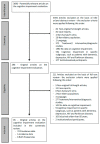Global Cognitive Impairment Prevalence and Incidence in Community Dwelling Older Adults-A Systematic Review
- PMID: 33121002
- PMCID: PMC7709591
- DOI: 10.3390/geriatrics5040084
Global Cognitive Impairment Prevalence and Incidence in Community Dwelling Older Adults-A Systematic Review
Abstract
(1) Background: We proposed to review worldwide estimates of cognitive impairment prevalence and incidence in adults older than 50 years of age living in the community. (2) Methods: Systematic searches were performed in January 2019 using MEDLINE/PubMed. Articles were selected if they referred to cognitive impairment, prevalence, incidence, elders, and population or community-based studies. Analysis, aggregated by different methodologic features, was performed. (3) Results: Prevalence (80 studies) ranged between 5.1% and 41% with a median of 19.0% (25th percentile = 12.0%; 75th percentile = 24.90%). Incidence (11 studies) ranged from 22 to 76.8 per 1000 person-years with a median of 53.97 per 1000 person-years (25th percentile = 39.0; 75th percentile = 68.19). No statistically significant effects were found except for inclusion age. (4) Conclusion: We propose that the homogenization and clarification of the definition of what constitutes cognitive impairment are essential to refine the epidemiological understanding of this entity. The results of this review reinforce the importance of adherence to standardized cut-off scores for cognitive tests to promote study comparability.
Keywords: cognitive impairment; epidemiology; incidence; prevalence.
Conflict of interest statement
The authors declare no conflict of interest.
Figures



References
-
- UN . World Population Ageing 2015. United Nations; San Francisco, CA, USA: 2015.
-
- Crimmins E.M., Kim J.K., Langa K.M., Weir D.R. Assessment of cognition using surveys and neuropsychological assessment: The Health and Retirement Study and the Aging, Demographics, and Memory Study. J. Gerontol. B Psychol. Sci. Soc. Sci. 2011;66(Suppl. 1):i162–i171. doi: 10.1093/geronb/gbr048. - DOI - PMC - PubMed
-
- ICD-10. International Statistical Classification of Diseases and Related Health Problems 10th Revision. [(accessed on 10 January 2013)]; Available online: http://apps.who.int/classifications/icd10/browse/2010/en#/F06.7.
Publication types
LinkOut - more resources
Full Text Sources

